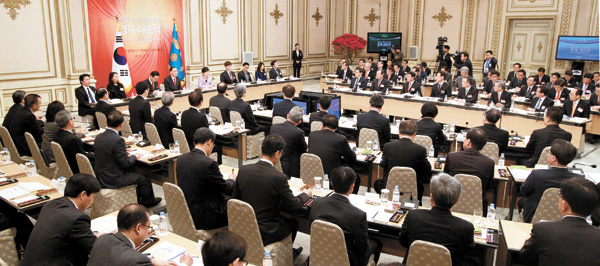Creative economy road map for 2015

President Park Geun-hye speaks during a joint report session by the Ministry of Science, ICT and Future Planning; Ministry of Trade, Industry and Energy, and three other agencies to announce their plans to boost the creative economy. The session was held Thursday at the Blue House in Seoul. [Joint Press Corps]
To make 2015 a boom year for its creative economy initiative, the Park Geun-hye administration will supply as much as 180 trillion won ($166.9 billion) for new growth engine businesses and start-ups.
The Ministry of Science, ICT and Future Planning, the Financial Services Commission (FSC), and the Ministry of Trade, Industry and Energy, in addition to two other state-run agencies related to the economy, held a joint session with the president Thursday to report on their plans to boost the creative economy.
While the first round report led by the Ministry of Strategy and Finance and the Ministry of Land, Infrastructure and Transport on Tuesday was about structural reform, the latest report focused on increasing the vitality of the Korean economy.
The main ideas are to establish a start-up friendly ecosystem, shift to smart manufacturing for traditional industries and make full use of the country’s free trade agreements, especially with China.
The Science Ministry and FSC will cooperate in many programs to help start-ups.
Aspiring entrepreneurs should welcome the government policy to establish Creative Economy Innovation Centers in as many as 17 cities in the first half of the year, where they can network with people of similar interests, launch start-ups and receive one-stop services in areas ranging from design to exporting that are provided by the government and conglomerates and tailored to each region.
The center in Seoul will focus on culture, led by CJ Group, and Gyeonggi will emphasize IT, led by KT. Incheon will concentrate on aerospace, backed by Hanjin Group, and Ulsan will be a center for shipbuilding with support from Hyundai Heavy Industries. Gwangju will specialize in automobiles under the guidance of Hyundai Motor, and Busan will spotlight the retail industry led by Lotte. Doosan will help with a center for machinery in South Gyeongsang and LG will support a biotechnology and energy center in North Chungcheong.
At the innovation centers, there will be “finance zones” where officials from five state-run public finance institutions permanently reside to offer government loans for start-ups.
In Yeoksam-dong, southern Seoul, the government will create a so-called High-tech Start-up Campus on a 10,000 square meters (2.5 acres) of land where as many as 160 teams can launch start-ups, which the government wants to develop as Seoul’s flagship Start-up Valley that can rival Silicon Valley. The government also will work with private businesses and angel investors to support research and development (R&D) by start-ups at the campus and provide up to 1 billion won for a maximum of three years.
Last year, the government spent 160 billion won to complete four centers in Gumi, Daegu in North Gyeongsang, Daejeon in South Chungcheong, and Jeonju in North Jeolla. Investment will be expanded to 600 billion won this year.
Funds for creative economy policies will come from the Korea Development Bank (63 trillion won), Industrial Bank of Korea (56 trillion won), Korea Credit Guarantee Fund (41 trillion won) and Korea Technology Finance Corporation (19 trillion won).
The Science Ministry also outlined its “Manufacturing Innovation Plan 3.0,” aimed at merging information technology with the manufacturing process. The goal of the plan is to encourage about 10,000 manufacturers to have “smart” factories that can integrate design, production and distribution with ICT technologies to cut costs.
The ministry also plans a 240 billion won investment by 2017 in the development of next-generation products such as eco-friendly ships, smart cars, new central processing units and drones.
The Trade Ministry aims to reach $600 billion in exports and $20 billion in foreign investment this year by utilizing the country’s FTA network, which represents more than 70 percent of global GDP.
“With the China FTA concluded, Korea will be the only significant economy in the world that has open trade agreements with the world’s top three powerhouses,” said Kwon Pyung-oh, deputy minister for international trade and investment.
Korea has FTAs with the United States and European Union. It reached a substantial conclusion with China on a bilateral FTA in November. The country has reached FTAs with 57 countries and 48 have been ratified.
For the Chinese market, the Trade Ministry will work with the Korea International Trade Association to set up a “China desk” in March to help small businesses sell in the world’s second-largest economy.
About 2,400 companies will receive support in the form of specialists hired by the government. The government also will provide a “Trade NAVI” service to give managers easy access to data and know-how on shipping abroad. Trade NAVI will provide information via smartphones.
President Park said Thursday Korea should consider striking free trade agreements with emerging countries to help boost exports.
“We should further expand our FTA network,” Park said in a meeting at the presidential office, where she received the ministries’ briefing.
The government will seek to upgrade existing FTAs with India and the Association of Southeast Asian Nations and engage in talks with Latin American, Central Asian and African countries, the ministry announced.
ssh@joongang.co.kr [BY SONG SU-HYUN ]










with the Korea JoongAng Daily
To write comments, please log in to one of the accounts.
Standards Board Policy (0/250자)